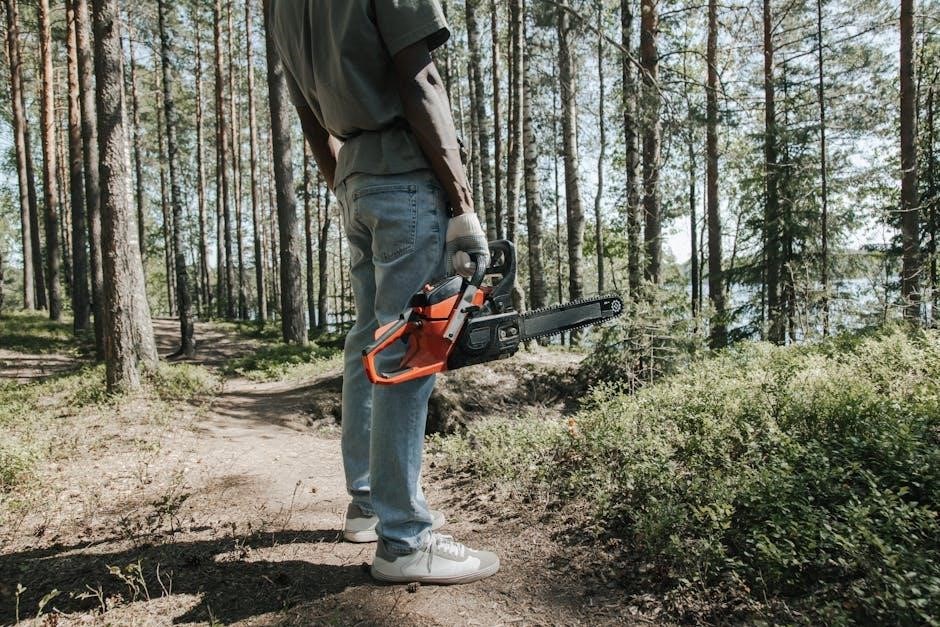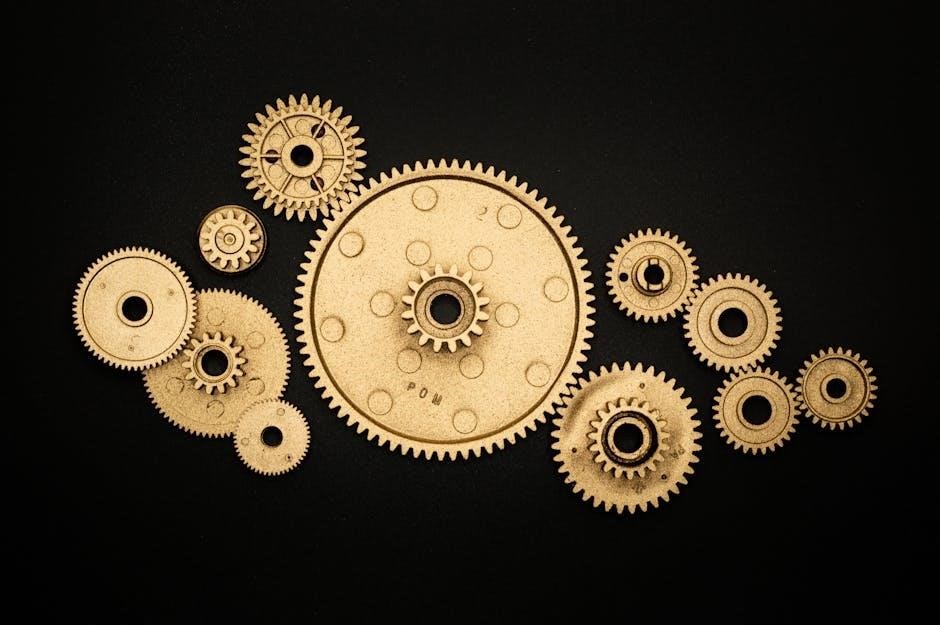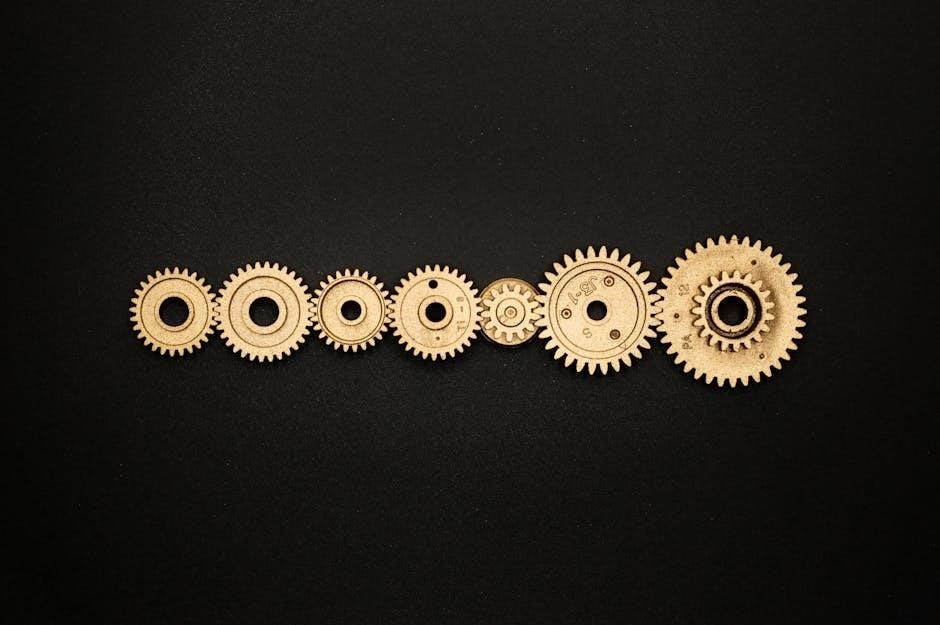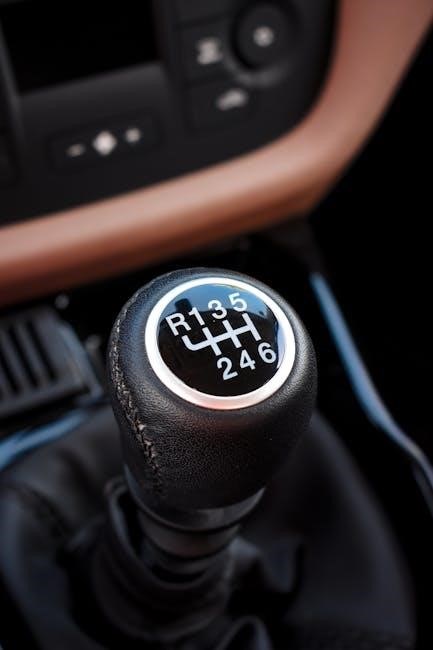Manual Transmission Kicks Out of Gear: Causes and Solutions
Manual transmissions can unexpectedly kick out of gear‚ presenting a frustrating and potentially dangerous situation for drivers. Understanding the common causes and effective solutions is crucial for maintaining vehicle safety and performance.
Manual transmissions‚ while offering a direct and engaging driving experience‚ are not immune to problems. One concerning issue is when the transmission unexpectedly kicks itself out of gear. This can happen across different gears and driving conditions‚ leading to loss of power and potential safety hazards. Diagnosing this issue requires a systematic approach‚ considering several potential root causes. This includes everything from worn internal components to external linkage problems. Addressing these problems promptly is essential for maintaining the vehicle’s reliability and ensuring a safe and enjoyable driving experience with your manual transmission vehicle.

Common Causes of a Manual Transmission Kicking Out of Gear
Several factors can cause a manual transmission to pop out of gear‚ ranging from worn internal components to issues with the external shift linkage‚ each requiring specific diagnostic steps.
Worn Synchronizers
Synchronizers play a crucial role in smoothly engaging gears within a manual transmission. When these components become worn or damaged‚ they can no longer effectively synchronize the speeds of the gears during shifting. This lack of synchronization can cause the transmission to pop out of gear‚ particularly during acceleration or when under load.
Worn synchronizer rings are a primary culprit‚ preventing proper gear engagement. Internal wear reduces their ability to mesh correctly‚ leading to disengagement. Replacing worn synchronizers is necessary to restore smooth shifting and prevent the transmission from popping out of gear. This ensures reliable and safe operation.
Faulty Shift Linkage and Bushings
The shift linkage connects the gear shifter to the transmission‚ enabling gear selection. Over time‚ the bushings within the linkage can wear out or become damaged‚ introducing excessive play and slop. This play can prevent the transmission from fully engaging a gear‚ leading to it popping out‚ especially under load.
Worn or loose linkage components hinder precise gear engagement. Inspecting and replacing worn bushings‚ rods‚ and other linkage parts is crucial for restoring proper shift engagement. Adjusting the shift linkage can also improve gear selection and prevent unwanted disengagement. Maintaining a properly functioning shift linkage ensures smooth and reliable gear changes.
Low or Contaminated Transmission Fluid
Transmission fluid lubricates the gears and synchronizers‚ facilitating smooth operation and reducing wear. Low fluid levels can lead to inadequate lubrication‚ causing increased friction and heat‚ potentially leading to gears not fully engaging. Contaminated fluid‚ containing debris or metal particles‚ can also hinder proper lubrication and damage internal components.
Insufficient lubrication caused by low or dirty fluid can prevent gears from meshing correctly‚ resulting in the transmission popping out of gear. Regularly checking and replacing transmission fluid ensures optimal lubrication and cooling‚ preventing premature wear and maintaining proper gear engagement. Using the correct type of fluid is essential.
Worn Gear Shift Fork or Broken Poppet Spring
The gear shift fork is responsible for moving the synchronizer to engage a specific gear. Over time‚ the shift fork can wear down‚ leading to incomplete gear engagement. A worn fork may not fully slide the synchronizer‚ causing the gear to slip out under load.
Poppet springs maintain the position of the shift rail‚ ensuring the transmission stays in the selected gear. If a poppet spring is broken or weakened‚ it can allow the shift rail to move unintentionally‚ causing the transmission to pop out of gear‚ especially during acceleration or deceleration.
Internal Transmission Failure (Shift Fork Assembly‚ Synchronizer)
Internal transmission components‚ like the shift fork assembly and synchronizers‚ are susceptible to failure due to wear and tear or excessive stress. The shift fork assembly ensures proper gear engagement‚ and damage can lead to gears popping out. Synchronizers are vital for smooth gear changes; worn synchronizers often cause gears to disengage unexpectedly.
If the transmission consistently pops out of specific gears‚ it indicates a larger internal problem. Addressing these failures often requires a professional mechanic to diagnose and repair the transmission to restore proper functionality and reliability.
Worn Mounts or Loose Linkage
Worn transmission mounts and loose shift linkages can significantly contribute to a manual transmission popping out of gear. Transmission mounts secure the transmission to the vehicle’s frame‚ and when they deteriorate‚ the transmission can shift excessively‚ affecting gear engagement. Similarly‚ loose or damaged shift linkages create play in the gear selection process.
This play can prevent the transmission from fully engaging in gear‚ leading to unexpected disengagement. Regular inspection and timely replacement of worn mounts and linkages are essential for maintaining proper gear engagement and overall transmission health.
Weak Spring in the Shift Rail
A weak spring in the shift rail can also be a culprit behind a manual transmission popping out of gear. The shift rail is a crucial component within the transmission‚ responsible for holding the gears in their selected positions. A spring provides the necessary tension to maintain the gear’s engagement.
If the spring weakens or breaks‚ it may not exert enough force to keep the gear securely in place. This can result in the transmission unexpectedly slipping out of gear‚ particularly under load or during acceleration. Replacing the weak spring can restore proper gear engagement.

Clutch-Related Issues
Clutch-related problems can significantly contribute to a manual transmission kicking out of gear. Issues like incomplete disengagement or excessive play can disrupt the gear engagement process‚ leading to unexpected disconnections.
Clutch Not Fully Releasing
One significant cause of a manual transmission kicking out of gear is when the clutch fails to fully release. This incomplete disengagement can stem from various factors‚ including a seized pilot bushing which allows play in the main shaft‚ hindering the smooth transition between gears.
When the clutch doesn’t fully disengage‚ it creates persistent drag between the engine and transmission. This drag interferes with proper gear engagement‚ potentially causing gears to grind during shifts or even pop out of gear unexpectedly. Addressing this issue promptly is essential.
A malfunctioning clutch impacts synchronizer function and overall gear engagement. Identifying and resolving the root cause ensures smoother operation and prevents more serious transmission damage‚ restoring optimal driving performance and safety.

Too Much Play in Fork or Release Bearing
Excessive play within the clutch fork or release bearing mechanisms can significantly contribute to a manual transmission’s tendency to kick out of gear. When there’s too much free movement in these components‚ the clutch may not fully disengage during gear changes.
This incomplete disengagement places undue stress on the synchronizers‚ leading to premature wear and increasing the likelihood of gears popping out. Furthermore‚ the improper clutch action can cause jerky shifts and difficulty engaging gears smoothly.
Addressing excessive play in the fork or release bearing involves careful inspection and potential replacement of worn components. Maintaining proper clutch linkage adjustments and ensuring smooth bearing operation are crucial for preventing gear disengagement issues and preserving transmission health.
Bad Pilot Bearing
A failing pilot bearing can significantly contribute to a manual transmission kicking out of gear. The pilot bearing‚ located within the crankshaft‚ supports the transmission’s input shaft. When this bearing wears out or becomes damaged‚ it can cause misalignment and instability in the input shaft.
This misalignment can lead to vibrations and difficulty engaging gears smoothly. Moreover‚ a bad pilot bearing can prevent the clutch from fully disengaging‚ placing undue stress on the synchronizers and increasing the likelihood of gears popping out of position‚ particularly under load or during acceleration.
Replacing a faulty pilot bearing is crucial for restoring proper alignment and clutch function. Neglecting this issue can result in further transmission damage and potential gear failure‚ necessitating costly repairs. Regular inspection and maintenance can help prevent pilot bearing failures.

Specific Gear Problems
Certain gears‚ like 5th or 3rd‚ may be more prone to popping out due to wear or damage specific to their components within the transmission. This requires focused troubleshooting.
Popping Out of 5th Gear
A common issue with manual transmissions is the tendency to pop out of 5th gear. Several factors can contribute to this specific problem. Worn synchronizer rings‚ which are responsible for smoothly engaging the gear‚ are a primary suspect. Low or contaminated transmission fluid can also hinder proper gear engagement‚ leading to slippage. Additionally‚ issues with the shift linkage or improperly adjusted cables can prevent the gear from fully locking into place. Internal wear within the transmission‚ such as a faulty shift fork or damaged gear teeth‚ can also be the culprit. Addressing these potential causes requires careful inspection and repair by a qualified mechanic.
Issues with 3rd Gear
Experiencing problems specifically with 3rd gear in a manual transmission can indicate localized wear or damage. Potential causes include abnormal wear on internal components related to 3rd gear‚ such as the 3/4 slider and hub assembly. The shift fork responsible for engaging 3rd gear could also be damaged or bent‚ preventing proper engagement. Worn synchronizers‚ designed to match the speed of the gears during shifting‚ can also lead to difficulty staying in 3rd gear. Addressing this issue often requires a thorough inspection of the transmission’s internal components to identify the root cause and implement the necessary repairs or replacements.

Other Contributing Factors
Habits like resting your hand on the shifter while driving can contribute to the transmission popping out of gear. This puts undue pressure on the shift linkage‚ leading to premature wear and potential disengagement.
Resting Hand on Shifter
A seemingly harmless habit‚ resting your hand on the gear shifter while driving can exert subtle but persistent pressure on the shift linkage. This constant force‚ even if minimal‚ can lead to premature wear of the internal components responsible for keeping the transmission engaged in gear. Over time‚ this wear can cause the gears to disengage unexpectedly‚ resulting in the transmission popping out of gear.
Therefore‚ it’s crucial to avoid using the gear shifter as an armrest and instead keep both hands on the steering wheel for safer and prolonged transmission health.

Potential Dangers and Consequences
A manual transmission popping out of gear can lead to a sudden loss of power‚ potentially causing accidents‚ especially during turns or on highways. Ignoring this issue can also lead to internal damage.
Loss of Control
The sudden and unexpected nature of a manual transmission slipping out of gear can create hazardous driving conditions‚ potentially leading to a loss of vehicle control. This is particularly dangerous when navigating turns‚ merging onto highways‚ or driving in heavy traffic. The abrupt disengagement of the gears can catch the driver off guard‚ hindering their ability to react appropriately and maintain stability. The loss of power during critical maneuvers can increase the risk of accidents. It requires immediate driver attention and correction to regain control‚ demanding a swift response to avoid potential collisions or veering off course.

Internal Damage

Forcibly re-engaging a manual transmission that repeatedly pops out of gear can cause significant internal damage to the transmission components. The shift forks and gears are particularly vulnerable to strain and wear when subjected to repeated‚ forceful engagements. The constant stress and impact can lead to premature failure of these critical parts‚ resulting in costly repairs or even a complete transmission rebuild. Ignoring the underlying cause and continuing to drive with a faulty transmission can exacerbate the damage‚ leading to more extensive and expensive repairs down the line. Addressing the issue promptly is vital.

Troubleshooting and Solutions
Addressing a manual transmission that kicks out of gear requires systematic troubleshooting. This may involve checking fluid levels‚ adjusting linkage‚ or seeking professional inspection for internal repairs to resolve the issue.
Checking and Replacing Transmission Fluid
Low or contaminated transmission fluid is a frequent culprit behind manual transmissions popping out of gear. Regular checks are crucial; inspect the fluid level and condition using the dipstick‚ if equipped‚ or by removing the fill plug. The fluid should be clear and free of debris. Dark‚ sludgy fluid indicates contamination.
Replacing the fluid involves draining the old fluid and refilling with the manufacturer’s recommended type. Ensure the fill level is accurate. This simple maintenance step can often resolve issues and prevent further damage‚ improving gear engagement and overall transmission health‚ addressing potential slipping problems.
Adjusting or Repairing Shift Linkage
Shift linkage connects the gearshift lever to the transmission‚ enabling gear selection. Over time‚ wear and tear can cause play or looseness in the linkage‚ hindering precise gear engagement. This can lead to difficulty shifting and the transmission popping out of gear.
Begin by inspecting the linkage components for damage or excessive play. Adjustment may be possible by tightening bolts or replacing worn bushings. If the linkage is severely damaged‚ replacement is necessary. Proper adjustment ensures the shifter engages gears fully and securely‚ preventing unexpected disengagement and restoring smooth shifting.
Professional Inspection and Repair
If troubleshooting steps don’t resolve the issue of a manual transmission kicking out of gear‚ seeking professional help is advisable. A qualified mechanic possesses the expertise and specialized tools to diagnose complex transmission problems accurately. They can conduct thorough inspections‚ including internal component checks.
Internal issues like worn synchronizers‚ damaged shift forks‚ or other failures often require dismantling the transmission for repair or replacement. Attempting these repairs without the proper knowledge and equipment can lead to further damage. A professional ensures the job is done correctly‚ restoring the transmission to optimal functionality and performance.
